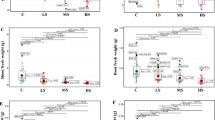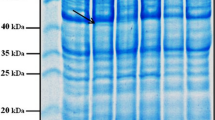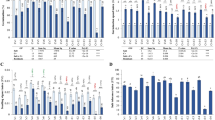Abstract
The present study examines ten wheat (5 Triticum aestivum, 4 T. durum, and 1 T. diccocum) genotypes for biochemical and RAPD markers associated with NaCl based salt tolerance capacity [T0 (control), T1 (50 mM NaCl), T2 (100 mM NaCl) and T3 (150 mM NaCl)]. The highest STI was obtained with four tolerant KH-65 (81.32), KRL-213 (81.24), DDK-1025 (80.70), and HI-8498 (80.00) wheat genotypes. The free proline was positively correlated with STI, followed by free amino acids and total sugars, suggesting their roles as osmolytes to overcome the salt stress in wheat genotypes. The RAPD analysis of wheat genotypes carried out with twenty-two RAPD primers generated a total of 129 alleles out of which 90 bands were polymorphic with an average of 4.09 bands and 65.1 % polymorphism per primer. The unique and genotype specific markers were obtained by eight RAPD primers. The phylogenetic analysis of wheat genotypes showed a Jaccard similarity coefficient in the range of 0.64–0.78. Clustering pattern of wheat genotype indicated four salt tolerant genotypes (one Triticum aestivum, two T. durum, one T. diccocum) grouped into one cluster and shared minimum (64 %) similarity with each other. The most tolerant two wheat genotypes KH-65 (T. aestivum) and KRL-213 (T. durum) were grouped together and shared maximum (78 %) similarity each other. The maximum five unique bands were found to discriminate salt tolerant KRL-213 and further characterization of salinity tolerant trait in wheat genotypes.


Similar content being viewed by others
References
Bagci, S. A., Ekiz, H., & Yilmaz, A. (2007). Salt tolerance of sixteen wheat genotypes during seedling growth. Turkish Journal of Agriculture and Forestry, 31, 363–372.
Bates, L. S., Waldren, R. P., & Teare, I. D. (1973). Rapid determination of free proline for water stress studies. Plant and Soil, 39, 205–207.
Bushuk, W. (1998). Wheat breeding for end product use. Euphytica, 100, 137–145.
Chavan, P. D., & Karadge, B. A. (1986). Growth, mineral nutrition, organic constituents and rate of photosynthesis in Sesbania quadriflora L. grown under saline condition. Plant and Soil, 93, 395–404.
Datta, J. K., Nag, S., Banerjee, A., & Mondal, N. K. (2009). Impact of salt stress on five varieties of wheat (Triticum aestivum L.) cultivars under laboratory condition. Journal of Applied Sciences and Environmental Management, 13, 93–97.
Dhanda, S. S., Sethi, G. S., & Behl, R. K. (2004). Indices of drought tolerance in wheat genotypes at early stages of plant growth. Journal of Agronomy and Crop Sciences, 1900, 6–12.
Dubois, M., Gillies, K. A., Hamilton, J. K., Reber, F. A., & Smith, F. (1956). Colorimetric methods of determination of sugars and related substances. Analytical Chemistry, 28, 350–352.
Fisher, R., & Yates, N. (1948). Statistical methods for research workers (12th ed., pp. 130–131). Edinburg: Oliver and Boyd. Biological monograph and manuals.
Ghislain, M., Zhang, D., Fajardo, D., Huamann, Z., & Hijmans, R. H. (1999). Marker assisted sampling of the cultivated Andean potato Solanum phureja collection using RAPD markers. Genetic Resources and Crop Evolution, 46, 547–555.
Goudarzi, M., & Pakniyat, H. (2009). Salinity causes increase in proline and protein contents and peroxidase activity in wheat cultivurs. Journal of Applied Sciences, 9, 348–353.
Labanauskar, C. K., Stolzy, L. H., & Handy, M. F. (1981). Protein and free amino acids in wheat grain as affected by soil types and salinity levels in irrigation water. Plant and Soil, 59, 229–316.
Lee, Y. P., & Takahashi, T. (1966). An improved determination of amino acids with the use of ninhydrin. Analytical Biochemistry, 14, 71–72.
Moghaieb, R., Talaat, N., Abdel-Hadi, A., Youssef, S., & Sharkawy, A. (2009). Genetic variation for salt tolerance in some bread and pasta wheat genotypes. Arab Journal of Biotechnology, 13, 125–142.
Nei, M. (1987). Molecular evolutionary genetics. New York: Columbia University Press.
Prakash, V., & Sastry, E. (1992). Effect of salinity on germination and seedling growth in wheat. Annals of Arid Zone Research, 31, 71–72.
Rahman, M., Malik, T., Chowdhary, M., Iqbal, M., & Zafar, Y. (2004). Application of random amplified polymorphic DNA (RAPD) technique for the identification of markers linked to salinity tolerance in wheat (Triticum Aestivum L.). Pakistan Journal of Botony, 36, 595–602.
Rahman, M., Soomro, U., Zahoor, M., & Gul, S. (2008). Effect of NaCl salinity on wheat (Triticum Aestivum L.) cultivurs. World Journal of Agricultural Sciences, 4, 398–403.
Saghai-Maroof, M. A., Soliman, K. M., Jorgensen, R. A., & Allard, R. W. (1984). Ribosomal DNA spacer-length polymorphism in barley: Mendelian inheritance, chromosomal location, and population dynamics. Proceedings of the National Academy of Sciences, 81, 8014–8018.
Sarkadi, L. S., Kocsy, G., & Sebestyen, Z. (2002). Effect of salt stress on free amino acid and polyamine content in cereals. Acta Biologica Szegediensis, 46, 73–75.
Singh, N. (1992). Dry land salinity in the Indo-Pakistan subcontinent. In Symposium on “Degradation Restoration of Arid Lands” (pp. 179–248). Lubbock, Texas: Texas Technical University.
Tiwari, V., & Shoran, J. (2011). Soils, plant growth and crop production. Indian Journal of Plant Physiology, 1, 54–64.
Zarkti, H., Ouabbou, H., Hilali, A., & Udupa, S. (2010). Detection of genetic diversity in moroccan durum wheat accessions using agro-morphological traits and microsatellite markers. African Journal of Agricultural Research, 5, 1837–1844.
Author information
Authors and Affiliations
Corresponding author
Rights and permissions
About this article
Cite this article
Vaja, K.N., Gajera, H.P., Katakpara, Z.A. et al. Biochemical indices and RAPD markers for salt tolerance in wheat genotypes. Ind J Plant Physiol. 21, 143–150 (2016). https://doi.org/10.1007/s40502-016-0215-6
Received:
Accepted:
Published:
Issue Date:
DOI: https://doi.org/10.1007/s40502-016-0215-6




